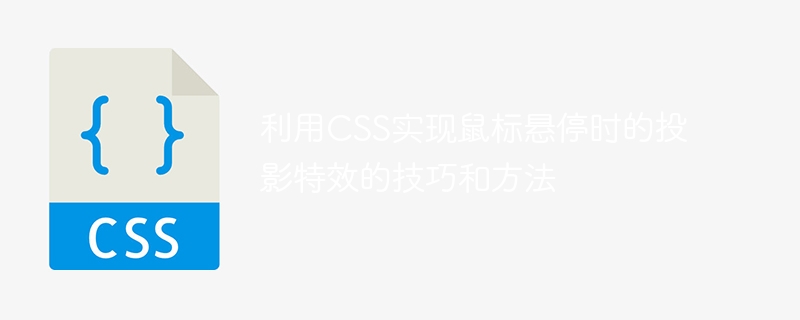

Techniques and methods of using CSS to achieve projection effects when the mouse is hovering
In modern web design, using CSS to achieve various special effects has become a common method practice. Among them, the shadow effect when the mouse is hovered is often used to increase interactivity and visual effects. This article will introduce techniques and methods to achieve this special effect, and provide specific code examples.
First of all, we need to clarify the goal: we hope that when the mouse hovers over the element, the element can produce a shadow effect to enhance the user's sense of operation. The key to achieving this effect is to use various properties and pseudo-classes of CSS to manipulate the style of elements.
First, we need to set the initial style for the element. Assuming that what we want to implement is a simple button element, we can use the following HTML code:
Next, we will add a shadow effect to the button through CSS. First, we can set a shadow style for the button, which can be achieved through thebox-shadowproperty. This property accepts a series of parameters, including the shadow's horizontal offset, vertical offset, blur radius, spread radius, and color. For example, we can set the following style:
.shadow-effect { box-shadow: 2px 2px 5px rgba(0, 0, 0, 0.2); }
The above code indicates that the shadow effect of the button element will be offset by 2 pixels in the horizontal direction and 2 pixels in the vertical direction, and the blur radius of the shadow is 5 pixels, and uses the rgba color format to specify the shadow color, and the last parameter represents the transparency of the shadow.
Next, we need to define that when the mouse hovers over the button, the style of the button element changes to produce a shadow effect. This requires the use of CSS pseudo-class selector:hover. By adding the:hoverpseudo-class selector to the button element, we can change the style of the button when the mouse is hovered. For example, we can set the shadow color of the button to red:
.shadow-effect:hover { box-shadow: 2px 2px 5px rgba(255, 0, 0, 0.2); }
The above code means that when the mouse hovers over the button, the shadow effect of the button element will turn red.
Through the above code, we have successfully implemented the projection effect when the mouse is hovering. In order to further enhance the visual effect, we can use transition effects to add animation effects to the state switching when the mouse hovers and leaves. For example, we can add the following transition effect to the button:
.shadow-effect { box-shadow: 2px 2px 5px rgba(0, 0, 0, 0.2); transition: box-shadow 0.3s ease; } .shadow-effect:hover { box-shadow: 2px 2px 10px rgba(255, 0, 0, 0.5); }
In the above code, we specify the transition of thebox-shadowattribute when the state switches through thetransitionattribute. The time is 0.3 seconds, and the transition animation ofeaseis used. In this way, when the mouse hovers the button, the shadow effect will have a 0.3 second gradient effect.
Of course, the above code is just a basic example, you can adjust and modify it according to your own needs and design style. In addition to thebox-shadowattribute, CSS also provides a series of other attributes for operating element styles, such asbackground-color,border, etc. You can use Use it flexibly according to specific needs.
In summary, the key to achieving the shadow effect when the mouse is hovering is to manipulate the style of the element through CSS properties and pseudo-class selectors. By properly setting shadow effects and transition effects, we can add richer interactivity and visual effects to web pages.
I hope this article will help you understand and apply CSS to achieve shadow effects when the mouse is hovering. The above code example is just a basic example, you can further adjust and extend it according to your own needs. I wish you can create more outstanding effects in your web design!
The above is the detailed content of Tips and methods for using CSS to achieve drop shadow effects when the mouse is hovering. For more information, please follow other related articles on the PHP Chinese website!